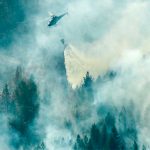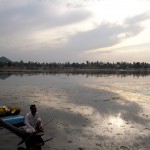IndiaWilds Newsletter Vol. 3 Issue XI
This issue of IndiaWilds Newsletter examines the present sad state of wildlife tourism, its negative impact and way forward. Your comments are appreciated at the end of the article.
Tourism destroying natural habitats:
Toilets on top of the world:
I was startled and astonished when I came across a news article about a demand for setting up of toilets in the Everest. Their reasoning was that though the mountaineers use portable toilets, the hordes of sherpas who are employed to carry luggage relieve themselves wherever they want and hence the need for toilets.
My initial reaction changed to sadness when the realization dawned by the extent of devastation we are wrecking on our pristine wilderness areas. The highest mountain peak in the world has seen many mountaineers attempting to scale it or �conquer� it as they say. Ever since this mountain was surveyed and given the tag of the highest mountain in the world, it has caught the imagination of mountaineers from around the world. There have been hundreds of deaths while attempting to scale this peak or while returning after a �successful� summit, often these are also due to people consciously attempting a difficult route. While it is difficult and beyond the scope of this article to talk about why this fascination to flirt with danger or glory – depending upon ones point of view � has continued for several decades, the point is that with the march of technology, there are better materials available for all your needs. Infact, it has become a thriving industry to help people climb the Everest. About 9 years back someone had asked me whether I am willing to spend 8000 dollars (eight thousand US dollars) to climb the Everest. I had politely declined the offer. I knew that I was physically not fit enough to undertake a successful climb of Everest and it is beneath my dignity to take that offer and be literally pulled up by sherpas. Nevertheless, that is what happens and wealthy tourists flock to the Everest so that they can brag about their latest �conquest�.
Wildlife tourism the �In Thing�:
And this is precisely what is happening these days. People with sufficient disposable wealth want to do something to get some bragging rights. And unfortunately, visiting wildlife destinations and wildlife photography is considered to be a �happening thing�, as I was told by a few youngsters whom I met in a National Park. The effect of this fad can be seen clearly in our well known national parks.
Tourists hound this radio collared tigress in Ranthambhore
Hordes of tourists screaming at their top of voice when they see a tiger; tourist jeeps jostling with each other for space hitting each other and hurling abuses; tourist vehicles and forest department elephants blocking the path of the tiger forcing to wait for hours away from water in a hot summer day so that tourists can get to see the tiger; tourist resorts coming up in ecologically fragile places; township developing to cater to the constant influx of tourists along with the attendant problems�. The list is endless.
Ranthambhore tiger stopped from hunting by photographers
Too much of tourism:
The fact is there are too many people visiting our few national parks, and it is beyond the carrying capacity of the place. Unfortunately, instead of restricting the number of tourists entering the forests, the draft eco-tourism guidelines by the MoEF talks about a formula which means tourist vehicles move around in a procession with a particular distance between them. Is this what our forests are meant to be? Degenerated into safari parks?
Touching and feeding a Nilgai in Tadoba
The late Kailash Sankhala, the first director and creator of the Project Tiger, had raised his voice against tourism several decades back.
Quoting Shri Kailash Sankhala from his book Tiger! The story of the Indian Tiger �I would suggest we concentrate on creating reserves where man�s interference � or what he arrogantly calls �scientific management� � is minimal. I do not like the term �national parks�, for it has been too loosely used. The initial meaning of �the untouched glory of God� has been so diluted that it has lost its significance. The term �park� conveys artificiality and the word �national� limits its universal appeal. The pleasure of a visit to a natural area has been destroyed by the influx of tourists with their transistors and trailers. I would condemn even the camera, except in case of professionals who employ their skill to interpret nature for the benefit of those millions who never get the chance to visit these gardens of Eden. The casual visitor is always in a hurry, and if he takes pictures he fails to see anything around him; his mind is preoccupied with shutter speeds, lens openings and focusing. The uncertainty of the results haunt him for hours after and instead of enjoying a relaxed holiday he is tensed. Many a wildlife photographer does not hesitate to disturb, sometimes even kill an animal, pluck a flower or destroy a tree to suit his picture. The visitor to a reserve should bring with him nothing but a receptive mind, and take away nothing but the understanding that he is only a small part of the whole complex pattern of nature�s ecology.�
An analysis of the impact of tourism infrastructure in Ranthambhore can be found here:
(http://www.indiawilds.com/diary/indiawilds-newsletter-vol-2-issue-v/).
Wildlife tourism is supposed to be non-consumptive and have minimal impact on wildlife and wilderness areas. However, the way wildlife tourism is run in this country, it is having a huge negative impact on the wilderness areas and wildlife. A tiger cub was mowed down by a tourist vehicle in Bandhavgarh on 21st April 2009 (for details please check here:http://www.indiawilds.com/diary/indiawilds-newsletter-vol-1-issue-v/) and the case meandered towards a natural death. It is a different matter that the tour operator in this case, as well as most of the tour operators call themselves tiger experts, bringing into light the issue of lack of any control or license. A year after this, a tigress was mowed down by a forest department vehicle in the night, while doing an illegal night safari for some influential persons (For details check here: http://www.indiawilds.com/diary/bandhavgarh-tigress-runover-by-jeep/). Predictably this case too made no headway. Despite this the tour operators maintain that they are eco-friendly.
The tour operators associations say that there are a �few black sheep� in the tourism industry who bring disrepute, else more or less the tourist operators are ethical and are the champions of conservation.
Nothing can be farthest from the truth!
PIL to Ban Tourism in Core Areas:
Recently, a PIL being heard in the Supreme Court to ban tourism in the core areas of the tiger reserves has brought the conflict of tourism vis-a-vis conservation into the open. The NTCA (National Tiger Conservation Authority) has favoured the proposal to ban tourism in the core areas. Predictably this has irked the tourism community.
Interestingly, a part of the conservation community � NGOs, media, and a few so called conservationists � have sprung to the defence of the tourist operators. Tourism is a cash cow and many players have a stake in that which includes wildlife activists, forest officials, tribal rights activists, researchers and other NGOs. It is standard ethical practice which warrants people who have a stake in the tourism pie, should refrain from offering their views as conservationists in this issue.
This case in the Supreme Court can have far reaching consequences. The tribal rights activists say that since the conservationists have argued that there is a need for inviolate spaces – and there have been a few successful efforts to shift villages from the core areas � there should not be any human foot fall in these core areas. However, no human footfall is an impracticable idea and can�t be implemented as well.
It is a fact that we need inviolate areas for our wildlife. And it is also a fact that the tourism in its present avatar is highly counter-productive and needs to be streamlined and curtailed in certain areas. I firmly believe and agree with Kailash Sankhala that human interference should be restricted to the minimum and allow �professionals who employ their skill to interpret nature for the benefit of those millions who never get the chance to visit these gardens of Eden� and patrolling units for the protection of these forests. Road building activities inside the core area should be immediately discontinued.
Lack of Tourism Policy:
Unfortunately, the present state of affairs in the tourism arena is such that it is absolutely difficult to derive pleasure during our visits to the forests. It is sad that lack of tourism policy, is pushing our forests into such an abhorrent state. My analysis of the ecotourism practices in Botswana (http://www.indiawilds.com/diary/indiawilds-newsletter-vol-2-issue-iv/)was shared with the MoEF. A year later MoEF came out with its draft Eco-tourism guidelines which appeared to be hurried collated (my analysis of it appeared in the IndiaWilds Newsletter Vol. 3 Issue VI http://www.indiawilds.com/diary/indiawilds-newsletter-vol-3-issue-vi/). It is really unfortunately, that the men and women in power instead of taking a holistic view are playing the game of blind men and the elephant and interpreting this as per their convenience.
The way tourism is run in this country needs to be regulated. At a minimum the following points needs to be tackled immediately:
Ecotourism Operators:
- Due diligence should be carried out before allowing any groups or individuals to set up resorts in sensitive areas.
- Effort should be to minimize concrete or permanent structures. Absolutely no concrete inside the forests. Instead promote camping using tents.
- The individuals, groups, organizations entering into this field should show their commitment to recruit the right kind of resources, adopt best practices etc.
- The Government may help them in enriching their knowledge from time to time by creating a best practices compendium, organizing seminars etc.
Where:
- At present tourism operators are crowded around a few places. In the absence of any legislation, our tourism operators will only move to well established areas to pick up the low hanging fruit first. For example, when CC Africa (a group well known for its ecotourism practices in Africa) set up its operations in India along with Taj (India�s one of the top most ethical organization); they set up their operations in well known areas like Kanha, Bandhavgarh etc instead of venturing into little known places. In sharp contrast, Jungle Lodges, a unit of Govt. of Karnataka�s Tourism Department, popularized BR Hills as a wildlife destination after setting up their resort in a relatively unknown place like K Gudi.
- New areas should be identified, the carrying capacity measured and tourist operators invited to set up their services in a controlled manner. Tour operators in these less visited areas can provide camping experiences by taking people on treks.
How:
- EIA done by reputed professionals and open to public scrutiny. There should be annual Environment Impact Assessment of the resort.
- Local construction materials used. The design should be in sync with the landscape. The construction should be based on the local conditions like weather, fragile environment, water scarcity etc. Brick-and-mortar resorts should be avoided in environmentally sensitive areas.
- A cradle to grave approach should be used to monitor the entire lifecycle of all materials used in construction.
- The resort should have a knowledgeable ecologist/naturalist as part of the team.
- Though it is good to promote Traditional crafts and culture. It should not be made a practice to conduct tribal dance, sale of handicrafts and other items in the forest. Else, this brings in more people from outside to setup shops. A well known case is Tala village in Bandhavgarh which had around 6 original families and now it is a small town offering even massage joints.
- In case the land is already degraded, the tour operator should take action to restore it along with its original vegetation.
- The Government should create a list of plants and trees in each area and make it mandatory for the resorts to adhere to it. The ecotourism site should be landscaped with vegetation native to that area. Landscaping should not be meant as creating lawns.
- Air-conditioners go against the grain of Ecotourism. The use of local materials, natural ventilation and local trees shading the cottages would help in removing the requirement of air conditioners.
- Light pollution should be minimized by designing appropriate lighting.
- Energy conservation should be prioritized. Renewable energy, especially solar energy should be used in the ecotourism facilities. The Government should provide adequate subsidies. A monitoring mechanism should be set up. Solar panels should be used for both, heat water as well as generate electricity for select appliances such as fans, lights, and kitchen equipment, water heating etc. Occupancy sensors should be used to cut down on unnecessary electricity consumption.
- It is estimated that approximately 30% water use in resorts is used for toilet flushing. Low flush toilets should be used to cut down on the water requirements.
- All cleaners, polishes and pesticide must be biodegradable, noncorrosive, non toxic and phosphate-free.
- All buildings should be connected by raised walkways to prevent vegetation from being trampled. Ground cover and other plant and animal life continues to flourish underneath the raised walkways and tent-cabins, and the trees and vegetation whose lives we spared return the favor by protecting us and our guests from the hot tropical sun. A similar structure is present in the White Tiger Lodge in Bandhavgarh.
Our wilderness areas and wildlife cannot be subservient to anyone�s interests and should not suffer due to the negligence of forest department in implementing laws or due to the inability of the law makers to frame adequate laws. I hope the Supreme Court case acts as a trigger to much needed action. Some news articles and discussions can be found here: http://www.indiawilds.com/forums/showthread.php?t=7895
Other Conservation Issues:
Windmill Projects and bird hits:
http://www.indiawilds.com/forums/showthread.php?t=7948
Navy�s Andaman & Nicobar missile test plan threatens Nicobar Megapode
http://www.indiawilds.com/forums/showthread.php?t=7899
Articles in IndiaWilds:
IndiaWilds invites articles written on various conservation,scientific and natural history issues. For further details you may mail at administrator@indiawilds.com
Wildlife Photography:
Images shared by our members between 10thOct 2011 � 9thNov 2011 that depict interesting behavior, habitat or are just plain beautiful.
A rare sighting: Red Fox by Dipankar Mazumdar
http://www.indiawilds.com/forums/showthread.php?t=7875
A rare sighting: Musk Deer by Kaling Dai
http://www.indiawilds.com/forums/showthread.php?t=7784
Blackbuck female by Jitendra Katre
http://www.indiawilds.com/forums/showthread.php?t=7800
Green bee-eaters in action by Atul Sinai
http://www.indiawilds.com/forums/showthread.php?t=7902
Coppersmith barbet by Dr. Kalpamoi Kakati
http://www.indiawilds.com/forums/showthread.php?t=7726
Common Crow Chrysalis by Abhishek Jamalabad
http://www.indiawilds.com/forums/showthread.php?t=7673
Lizard by Mohan Matang
http://www.indiawilds.com/forums/showthread.php?t=7737
Snail by Jitendra Katre
http://www.indiawilds.com/forums/showthread.php?t=7762
I look forward to your inputs and your support in preserving the last tracts of wilderness and wildlife left in this beautiful country. For other interesting articles and photographs please check: http://www.indiawilds.com/forums/
All the newsletters can be found online at: http://www.indiawilds.com/diary/category/newsletter/
In case, anyone of you has forgotten his/her user id and password can email the admin at the following email id administrator@indiawilds.comOthers may register at www.indiawilds.com/forums/register.php using your Full Name as user id.
Regards,
Sabyasachi Patra
www.indiawilds.com
Profile:�http://www.indiawilds.com/profile.htm
Contact:�http://www.indiawilds.com/contact%20us.htm
Facebook:�http://www.facebook.com/pages/IndiaWilds/132629240481www.indiawilds.com
Diary: http://www.indiawilds.com/diary/
Equipment reviews: http://www.indiawilds.com/diary/category/equipment/
Forums: http://www.indiawilds.com/forums/index.php
- GoPro Hero 12 Black - 6 September,2023
- Leopards: The Last Stand - 2 July,2023
- Drifting in the Waters of Sundarbans - 26 March,2023













Dear Patra Sir,
You really catches the actual picture of latest tourism trend in wildlife tourism topic clearly indicates tourist psychology and behavior in wildlife and national park area. The toilets on the top of world topic make me realize about the severe condition of sanitation condition even on high pick.
I felt need of awareness among the tourist about the wildlife and their ecosystem. Also at the same time there is need of strict measures against the people who intentionally broke the forest rules and regulations.
Dear mr. Sabyasachi,
i share and understand your anguish around the issue which you are so nicely highlighting. My only submission is there is a very deep need of intensive education process especially amongst the general public and the people who visit the forests and other ecological areas for ‘tourism’ i don’t believe that stopping people from accessing these areas is the answer rather creating an environment of responsible behaviour certainly is. I know that it is easier said than done, but i do not see any other option.
Some measures could be –
Restricting the number of people visiting at a given particular time and season.
Prior information about this is very critical so that people are facilitated to plan accordingly
A Nature Interpretation centre which is functional and mandatory for all who visit the area. Education about Do’s and Dont’s compulsory for all visiting the area.
Carrying of cell phones should be banned so is the case with all noise making devices.
Cameras i see are one way of capturing memories which should not be denied, but strict monitoring of the same and charges for carrying the cameras should be levied.